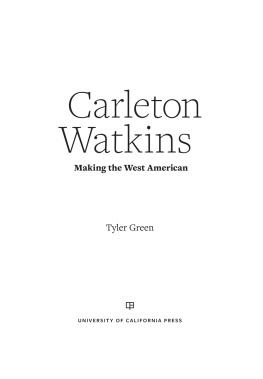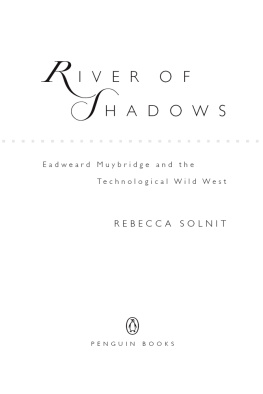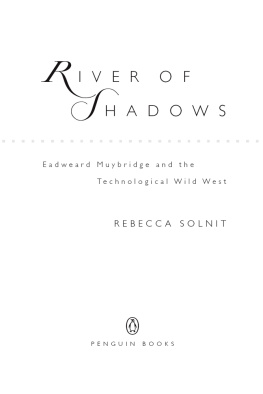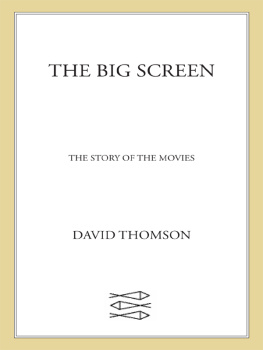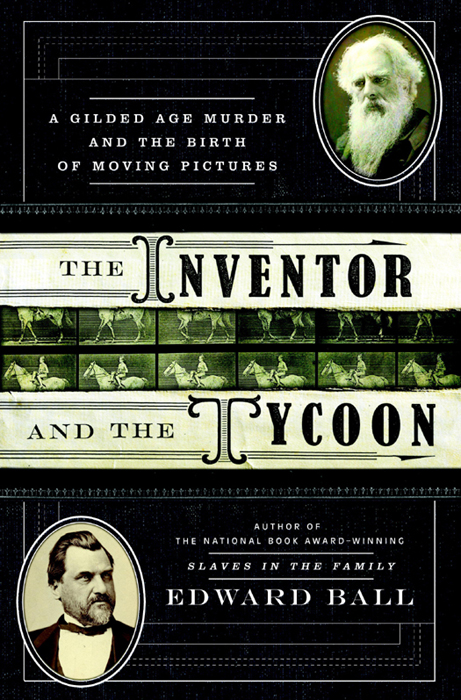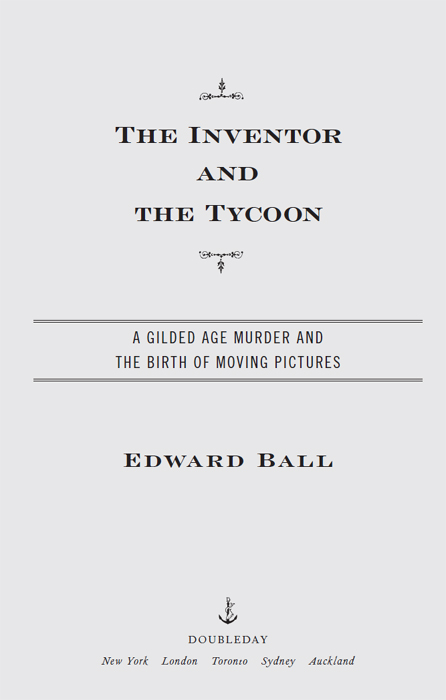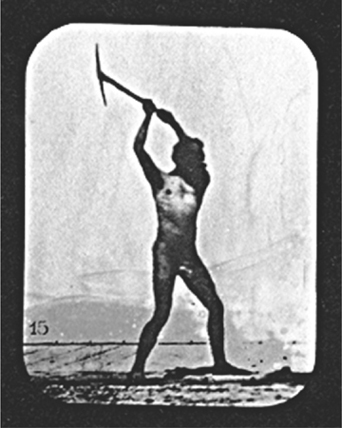
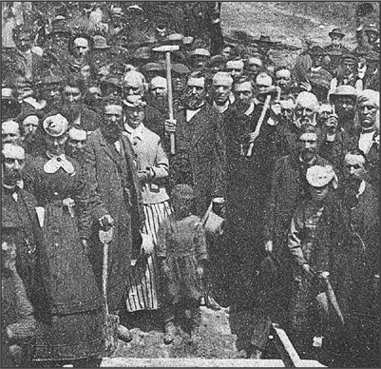
Frontispiece photographs: (top) Eadweard Muybridge, self-portrait, swinging a railroad linemans pickax, 1879; (bottom) Leland Stanford (center, a hammer in his right hand) during the last spike ceremony at the completion of the transcontinental railroad, Promontory Summit, Utah, May 10, 1869
Copyright 2013 by Edward Ball
All rights reserved. Published in the United States by Doubleday, a division of Random House, Inc., New York, and in Canada by Random House of Canada Limited, Toronto.
www.doubleday.com
DOUBLEDAY and the portrayal of an anchor with a dolphin are registered trademarks of Random House, Inc.
constitutes an extension of this copyright page.
Cover design by Michael J. Windsor
Cover illustration Wellcome Library, London
Library of Congress Cataloging-in-Publication Data
Ball, Edward
The inventor and the tycoon : a Gilded Age murder and the birth of moving pictures / Edward Ball. 1st ed.
p. cm.
Includes bibliographical references.
(hardcover : alk. paper)
1. Muybridge, Eadweard, 18301904. 2. Muybridge, Eadweard, 18301904Trials, litigation, etc. 3. Stanford, Leland, 18241893. 4. Trials (Murder)CaliforniaSan Francisco. 5. CinematographyUnited StatesHistory. 6. Motion picturesUnited StatesHistory. 7. CinematographersCaliforniaBiography. 8. BusinesspeopleCaliforniaBiography. I. Title.
TR849.M84B35 2012
777dc23 2012019977
eISBN: 978-0-385-53549-6
v3.1
for Candace
C ONTENTS
F OREWORD
Floodwaters
The man with beaten clothes could be forgiven for his crime, because he had invented a new way of seeing.
In the late 1800s, in California, the photographer Edward Muybridge and the railroad capitalist Leland Stanford, whose lives and personalities differed sharply, made a strange and unforgettable discovery. Using horses and cameras and speed, Muybridge, the creative one, and Stanford, the rich one, built a technology of vision. Together they married the camera to the railroad and became the inventors of moving pictures, the basis of our culture of screenshandheld ones and televisions, theater screens and screens on counters and desks. For this they stand at the headwaters of the visual media. From Stanford and Muybridge came the first spray of images that became the stream of pictures in which most of us bathe for half our waking hours.
There is another uncommon thing about Muybridge and Stanford, namely, one of them was a murderer. Muybridge, the photographer, killed coolly and in a meticulous way, with the expectation that he would die as he killed. As an artist and inventor, Muybridge helped turn the world into a community of spectatorspeople who watch, transfixed by screens. As a killer, he fascinated Americans with his story of sexual possession. The photographers crime did not seem to trouble Stanford, his friend and patron, so common was murder in California during the frontier years, but the Muybridge killing became an early sensation, a fitting prelude to the technology he and Stanford loosed on the world. I should add that these things unfolded in a particular order. To be truthful about the sequence, Muybridge killed, and then came the invention of media.
P REFACE
The story of the people who improvised moving pictures and put them on a screen, during the 1870s, when everyone still rode horses and cut firewood, might be worth the trouble of telling by itself, but Edward Muybridge has an enigma to add to this feat, which is his crime. Muybridgeand his friend and patron, Leland Stanford (in the old sense, the moneyed man who pays for art)brought visual media into the world, a kind of seeing that grew from the kernel idea of motion studies. Thus began the source of distraction and pleasure that much of the world uses much of the time: moving pictures fill daily life and fascinate us. But the mystery that Muybridge carries is that he was a murderernot an accidental killer, but a cool one, and remorseless.
Edward Muybridges life as an artist and Muybridge shot animals and people performing daily tasksand his projection of these on screensas the genetic imprint of all the visual media. The strand that holds together all our ways of looking at screens is the fascination with what moves, which is satisfied by an apparatus that captures time and plays it back. This is the story of two difficult, important, and incompatible men who joined photography to the railroad, and in so doing opened an exit from the Machine Age and an entrance to our own virtual worlds.

There is one unusual obstacle to speaking about Eadweard Muybridge, as he is usually called, namely that my subjects name cannot be pronounced. It can hardly be spelled. The best I can do, aloud, is aid-weird my-bridge. It is a name that looks back at you and says, Well, so? And also, I am. Muybridge changed the spelling of his name every ten years or so; his many names float over his life like his dissolving pictures, and Eadweard Muybridge was merely the last version. He coined five spellings, using one and tossing it, choosing another and leaving that one behind. Although he called himself Edward Muybridge during the years of his most important work, I will use all of his names, as he himself did, attaching each to the time in his life that he assumed it.
Edward Muybridgeperipatetic, obsessed, murderouswas uncomfortable with renown and at the same time wanted it. And so to the first name, and to what happened.

Click to view a larger version of this image.
T HE S TANFORD E NTERTAINMENT
T he mansion in San Francisco had collapsed with the earthquake in 1906 and burned to nothing a day later in the fires. I walked up the face of Nob Hill to look at the place where it used to stand. Could there be a tiny remnant of this temple of money? The hill had been known as California Hill until Leland Stanford and family moved there in 1876, followed by their preposterously rich friends. After that it was Nob Hill. Stanford and the other nabobs (a word borrowed from Mughal India, trimmed in America to nobs) built houses that showed their money and looked with a possessive gaze at the city below. The day after the earthquake the fire came, on a Thursday morning in April, and the two disasters took down all the big houses but one.
At the top of Nob Hill today are apartment buildings, hotels, a little park. The place that survived, the last sign of the sovereigns who had set themselves up on these blocks, was the Flood house. James Flood, a mining multimillionaire, was one of the men who exploited the Comstock Lode, a thick vein of silver in Nevada that ended up in most coins. The fire had somehow wrapped around and missed his house. When the silver man died, the Flood mansion went into the hands of the Pacific-Union Club, which seems fittinga mens club whose members dote on money, the way the nabobs did. I looked at the Flood house, a megalith in brown stucco, and imagined it in its original setting, amid a colony of American palaces. The first and most ostentatious of them, the Stanford house, used to stand a block to the east, at California and Powell Streets. An eight-story hotel now occupied that site, planted over the ruins. Only the granite wall that used to frame the house remained.



